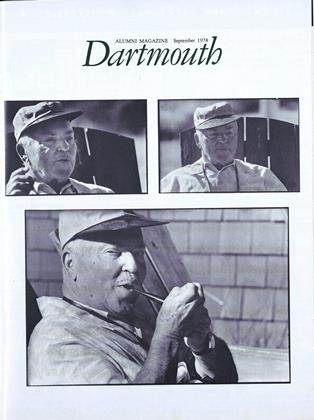"We are pleased with the achievement," said Vice President Addison Winship '42, with mild understatement, about the figure of $42,665,320 received in gifts and pledges by the end of the first year of the Campaign for Dartmouth. Fund-raisers often are given to ebullience, and a little on Winship's part would have been justified.
The first-year objective of the campaign was surpassed by $2 million, actual cash income of nearly $21.5 million was only slightly less than the previous record established during the Third Century Fund, and the Alumni Fund - which is considered part of the Campaign for Dartmouth - set its own record with gifts and pledges amounting to better than $5:3 million. The Alumni Fund goal was an even $5 million. Bequests and trusts climbed to a new level of $7.6 million.
Principal gifts in the $42 million total included the largest donation in Dartmouth's history, $4 million from the Sherman Fairchild Foundation; $2 million from Mr. and Mrs. Kenneth F. Montgomery '25; $1 million for an endowed chair at Tuck School from E. Bartley Osborn '28, who died suddenly in August; $1 million from Loren M. Berry for an endowed chair in economics; and an anonymous contribution of over $1 million for the construction of a new alumni center linked to a renovated Crosby House. The Fairchild gift will fund endowed chairs in engineering and the humanities, an endowment for Hopkins Center, and scholarships. A special visiting professorship, together with a residence for the visitor, has been established by the Montgomery gift. The total also includes contributions of approximately $11 million as part of a campaign nucleus fund provided by present and former Trustees and overseers of the associated schools and Hopkins Center.
The cheers weren't exactly muted for the Alumni Fund. Besides the record number of dollars, participation increased from last year to slightly more than 60.5 per cent. Other record-makers: the Class of 1918 - largest total ever by a 60-year class; the Class of 1923 - largest total by a 55-year class (plus a special fund of $2.3 million through lifetime gifts or bequests); the Class of 1949 - largest total by a 30-year class; the Class of 1973 - largest total by a five-year class; the Classes of 1954 and 1958 - the first non-reunion classes to surpass the $100,000 level.
Then there is the Class of 1953. Who can account for it? Self-styled as a kind of orphan class when on campus, a part of the dimly remembered Silent Generation, the careers of three quarters of its members delayed by military service, the class came to its 25th reunion in June in record numbers and went away with the College $1,000,053 richer for the experience. In fact, the gift, raised in a single year, left the College somewhat dumbfounded, and it was finally decided to allocate $750,000 to the Alumni Fund and the remainder to a Trustee discretionary fund.
The reunion gift by 1953 started modestly enough - by '53 standards - with a goal of $550,000. Then it began to edge upwards, soon overtaking the previous record of $626,000 by the Class of 1926. A few hours before the class reunion banquet the cup runneth over.
Below: With help from President Kemeny, three '53s - College Vice President Paul Paganucci, Frank Joslin, and Fred Stephens - hold the record aloft. It's the oldest picture in the fundraising book, but forgive us just this once.
 View Full Issue
View Full Issue
More From This Issue
-
 Feature
FeatureA Company of Stretchers
September 1978 By Cay Wieboldt -
 Feature
FeaturePoet at Full Ahead
September 1978 By Charles G. Bolte -
 Feature
FeatureTHE RIVER and THE DAMS
September 1978 -
 Article
ArticleA Journey: Five days to Big Rapids
September 1978 By Dan Nelson -
 Article
ArticleDickey-Lincoln: Who wants it? Who needs it?
September 1978 By Greg Hines -
 Article
Article'A Spirit of Fire and Air'
September 1978 By NARDI REEDER CAMPION







